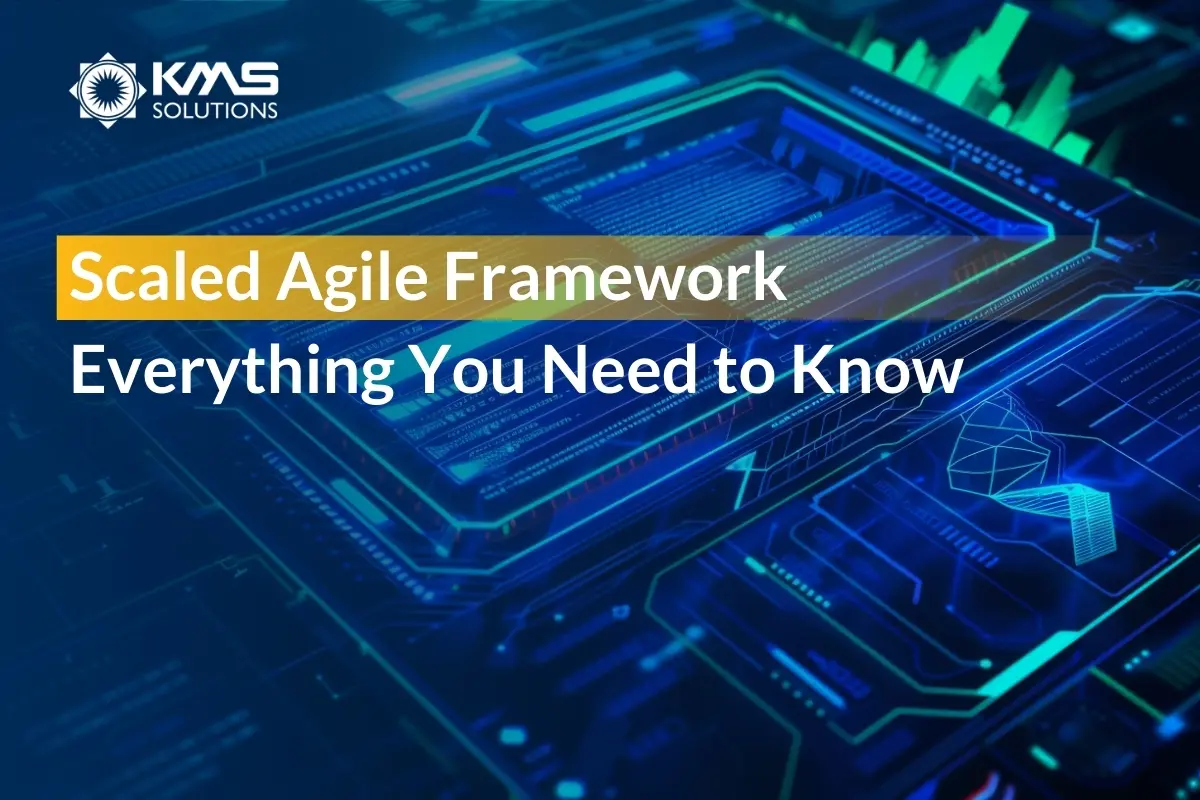The Scaled Agile Framework (SAFe) is a comprehensive methodology designed to help large organizations implement Agile practices at scale, enabling them to streamline operations, improve collaboration, and deliver value faster. As businesses face increasing complexity and the need for agility across teams, SAFe provides a structured approach that bridges the gap between strategy and execution.
In this article, we’ll explore everything you need to know about SAFe, from its core components to its benefits, implementation strategies, and how it can transform the way your organization operates.
1. What is Scaled Agile Framework (SAFe)?
The Scaled Agile Framework® (or SAFe® for short) is a system for scaling agile across an enterprise. As a comprehensive framework, SAFe offers guidelines and principles on key roles and their responsibilities, the workflow and patterns, as well as the values that should never be compromised.
SAFe incorporates principles from Lean, Agile, and DevOps, fostering enterprise-wide business agility, which accelerates value delivery, enhances quality, and boosts overall customer satisfaction.
SAFe is hardly a one-size-fits-all approach. As enterprises grow, there are four levels of SAFe to accommodate their size: Essential SAFe, Large Solution SAFe, Portfolio SAFe, and Full SAFe.
2. History of the Scaled Agile Framework
The Scaled Agile Framework (SAFe) was introduced by Dean Leffingwell in 2011 as a way to help large organizations scale their Agile practices. It was designed to integrate Lean and Agile principles into a unified framework to enhance business agility. The initial release offered a systematic approach to scaling Agile practices.
Since its inception, SAFe has undergone multiple iterations, with each version building upon the previous one to accommodate the evolving needs of modern enterprises. Below is a concise summary of the key milestones in SAFe’s evolution:
SAFe 1.0 (2012)
The first version of SAFe was introduced in 2012 at the Agile conference, offering a solution to scale Agile practices across teams in large enterprises. It introduced key concepts like Agile Release Trains (ARTs), which organize teams around value delivery. SAFe 1.0 was focused on coordinating the work of multiple Agile teams, ensuring they were aligned with the organization’s overall strategy.
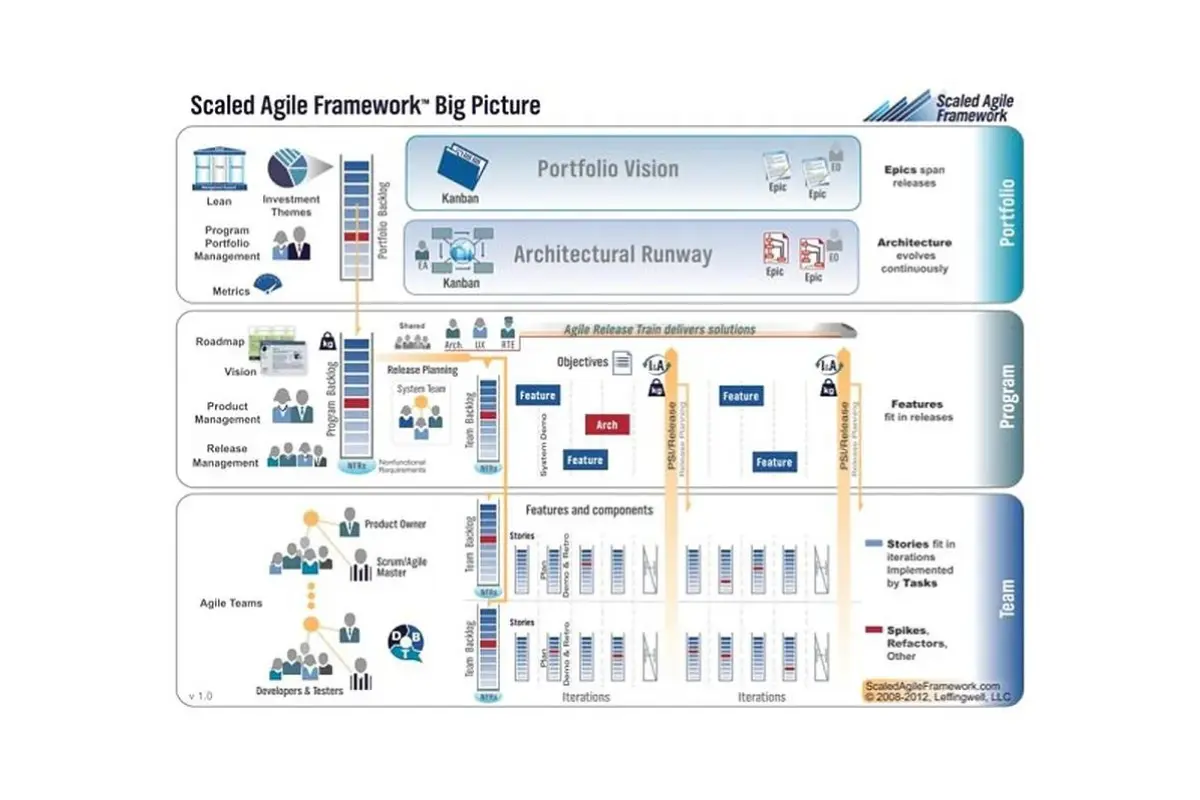
SAFe for Lean Systems Engineering (LSE) (2015)
In 2015, SAFe LSE was introduced as a separate framework aimed specifically at systems engineering for industries such as defense, medical, and transportation. It was designed for cyber-physical systems and provided comprehensive guidance for developing highly complex solutions involving multiple systems and technologies. This version underscored SAFe’s flexibility to adapt to different industry needs.
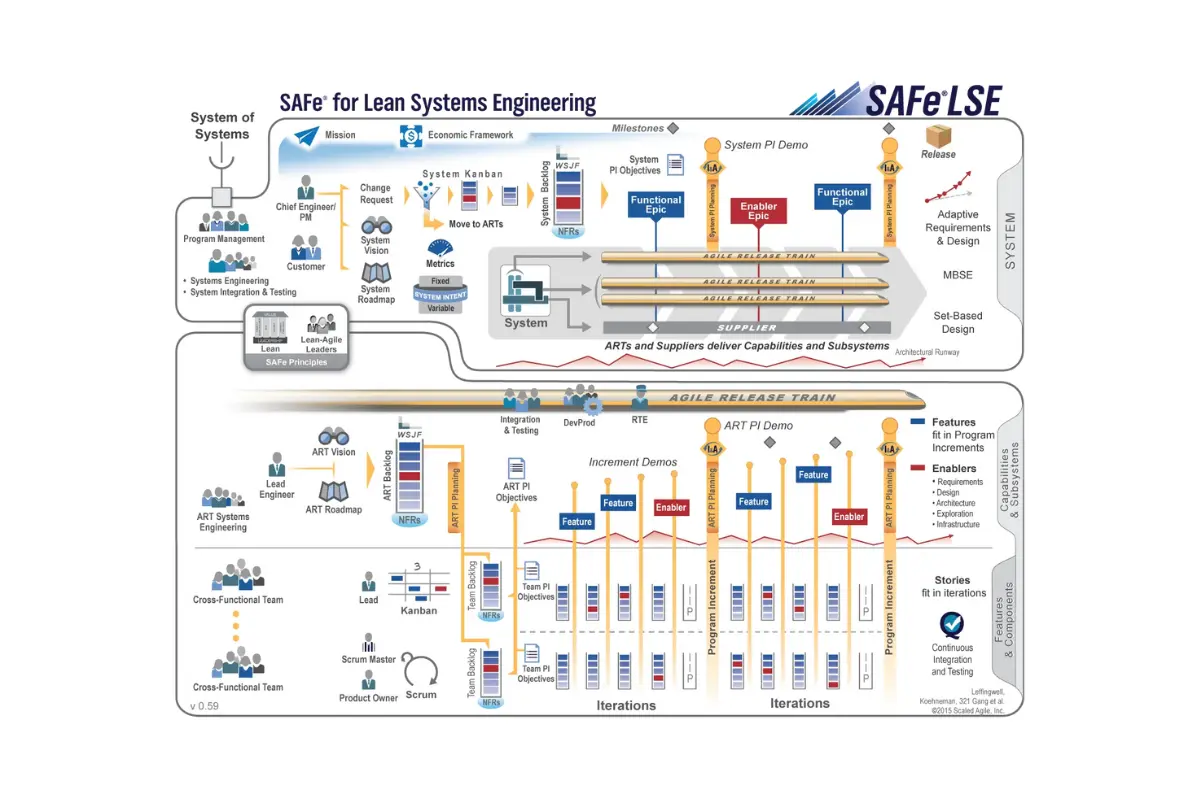
SAFe 4.0 (2016)
With SAFe 4.0, the framework expanded its focus to support both software and systems development. It introduced the Value Stream level, designed for large systems that require coordination across multiple teams. SAFe 4.0 also consolidated lessons learned from Lean Systems Engineering (LSE) and provided new layers such as the Foundations layer, which included principles like Core Values, Lean-Agile Mindset, and Built-in Quality practices.
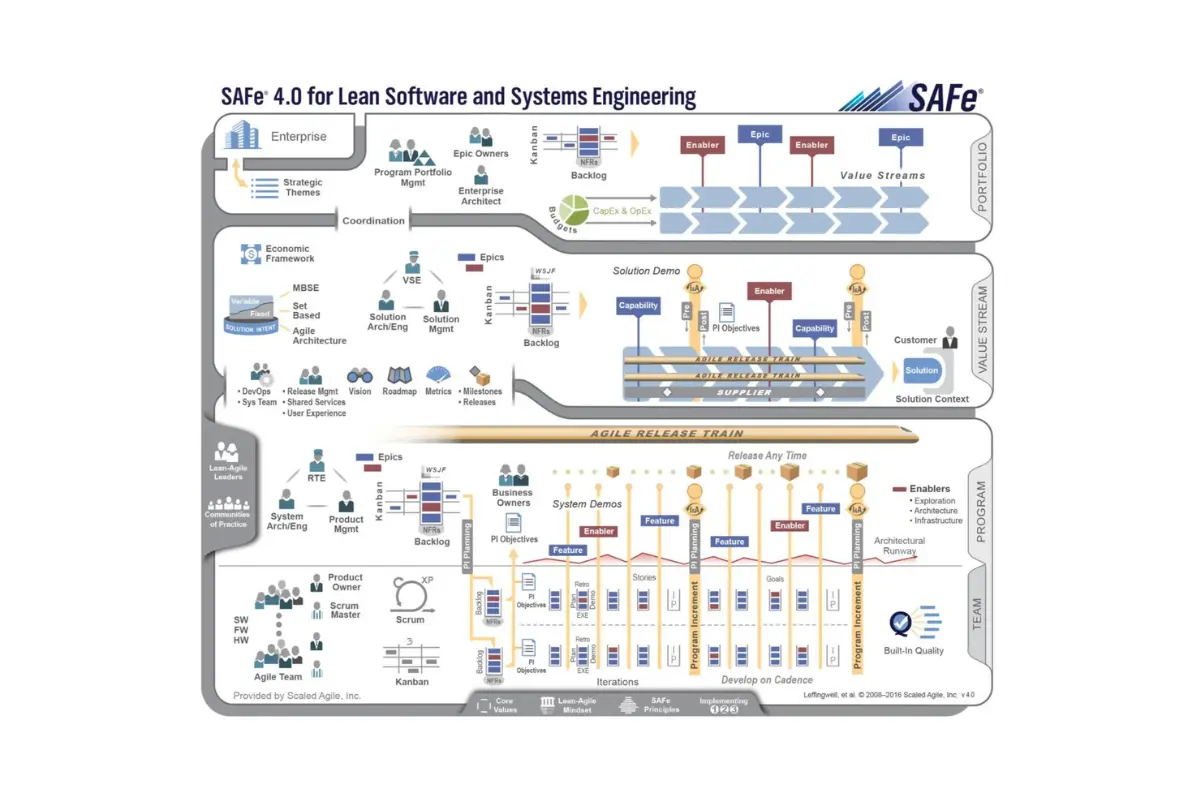
SAFe 5.0 (2019)
SAFe 5.0 was introduced at the 2019 SAFe Global Summit, highlighting Business Agility and Customer Centricity. This version introduced two additional core competencies: Continuous Learning Culture and Organizational Agility. It also placed greater importance on Design Thinking and Customer-Centric Development, highlighting the need to deliver value from the customer’s perspective. Additionally, SAFe 5.0 introduced SAFe Principle #10, which focuses on organizing teams around value.
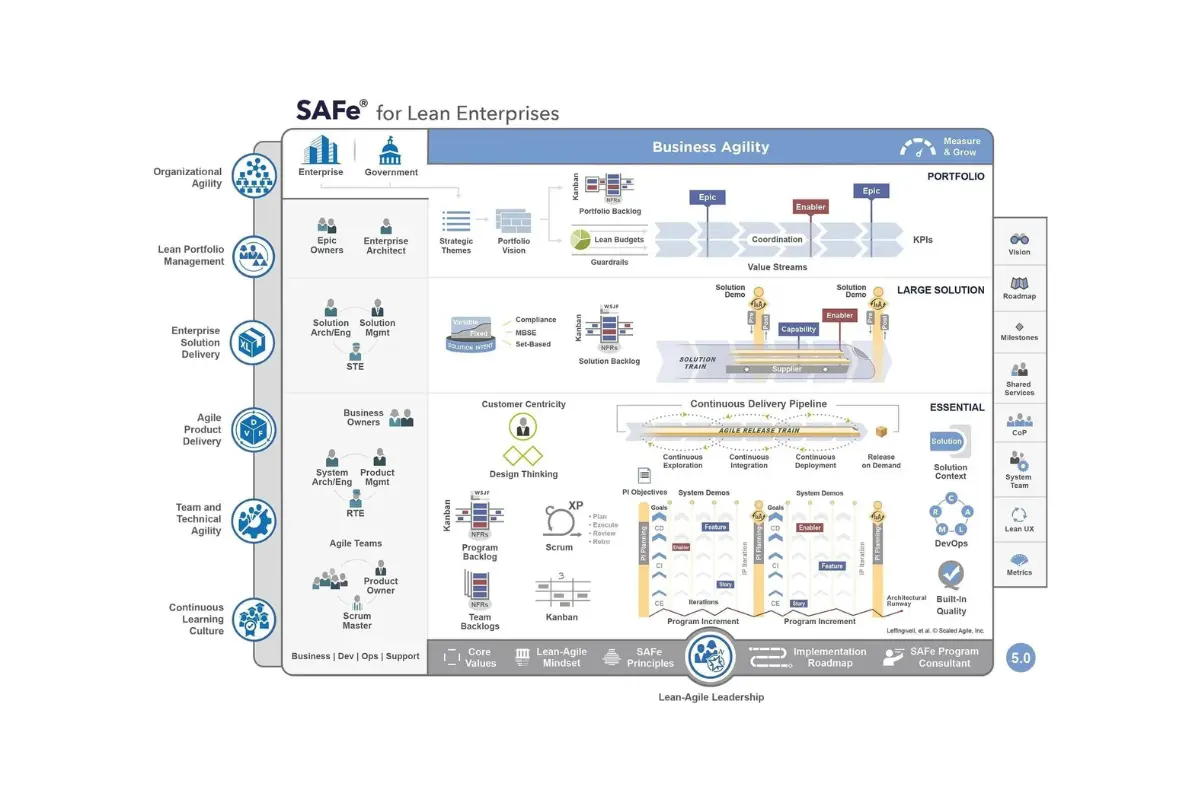
SAFe 6.0 (2023)
The most recent major update, SAFe 6.0, was launched in March 2023 and continues to build on the framework’s success by incorporating flow-based principles. It introduces six major themes that highlight Business Agility, with a focus on accelerating value flow across enterprises:
- Strengthening the foundation for Business Agility: SAFe 6.0 adds the Business Agility Value Stream and revises SAFe’s foundational elements like values, principles, and the Implementation Roadmap.
- Empowering teams and clarifying responsibilities: Updated role-based articles outline responsibilities more clearly.
- Accelerating Value Flow: Introduces eight key flow properties, updates SAFe Principle #6, and provides new tools and articles aimed at optimizing flow.
- Enhancing Business Agility across the enterprise: Expands on business and technology collaboration through Business-Enabled ARTs and Agile Business Trains.
- Building the future with AI, Big Data, and Cloud: Provides guidance on leveraging these emerging technologies.
- Delivering better outcomes with OKRs and Measure & Grow: Introduces OKRs to the spanning palette and renames metrics as Measure & Grow.
SAFe 6.0 also includes updates to its terminology, with the term “Program” being phased out in favor of “Solution”, standardizing the framework’s language.
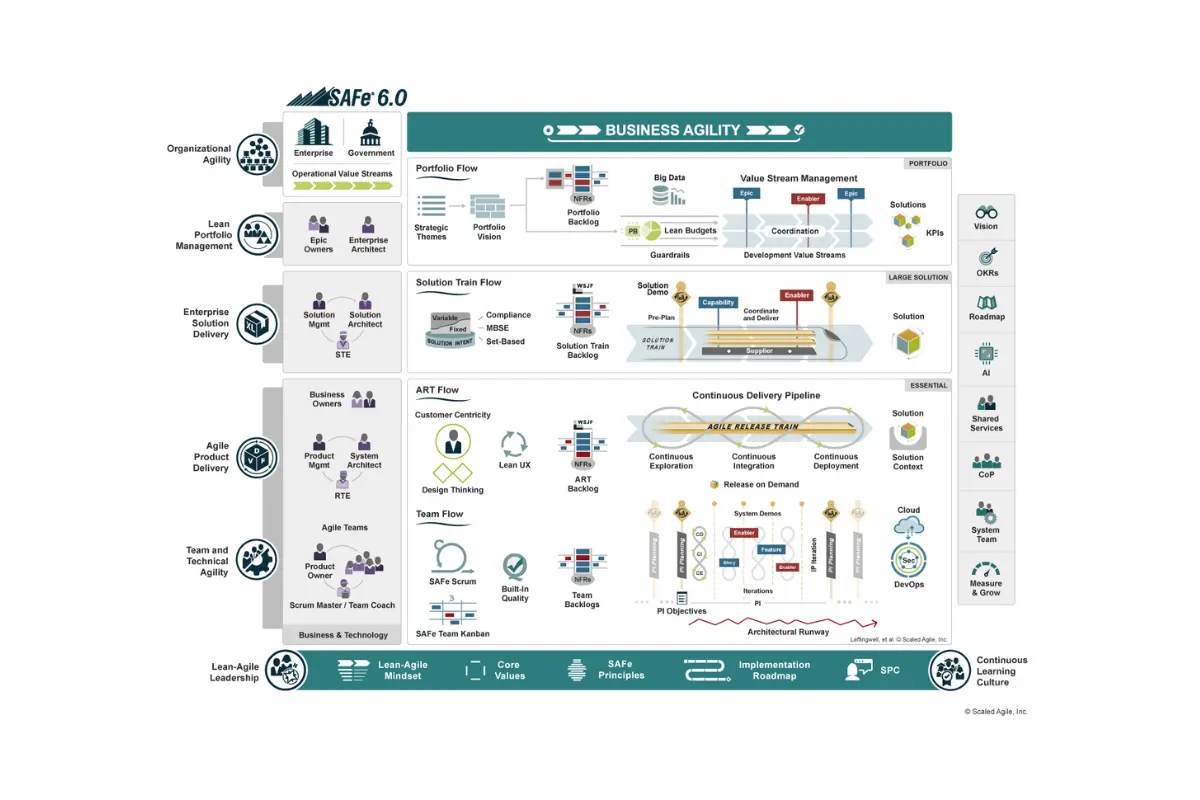
3. Core Values of SAFe
SAFe is grounded in a set of core values that shape the culture and behaviors necessary for successful implementation. These values provide a foundation for leadership and teams, guiding how they interact, collaborate, and drive results. By adhering to these values, organizations can ensure that SAFe is not only implemented but embraced in a way that fosters continuous improvement and high performance.
3.1 Alignment
SAFe aligns everyone on the same page. They have the same and transparent understanding of the enterprise, the goals, and the directions to achieve those goals. To reach this level of alignment, SAFe requires regular synchronization of activities and people.
Alignment in SAFe does not mean top-down control. Alignment happens when everyone is working toward the same goal, where empowerment, autonomy, and decentralized decision-making are promoted.
3.2 Built-In Quality
In SAFe, quality is a non-negotiable aspect of agility. The framework emphasizes that speed and flexibility should never come at the expense of delivering a high-quality product. Built-in quality is a fundamental principle that requires teams to establish clear definitions of what “done” means at every stage of the development process.
SAFe encourages teams to embed quality assurance practices throughout, ensuring that they don’t just focus on the outcome but maintain quality standards at every step of development.
The framework identifies five dimensions of built-in quality:
- Flow: Ensuring smooth and predictable delivery.
- Architecture and Design Quality: Maintaining high standards in structural integrity and scalability.
- Code Quality: Writing clean, efficient, and sustainable code.
- System Quality: Guaranteeing that the overall system is reliable and secure.
- Release Quality: Delivering solutions that meet the highest performance and usability standards.
By incorporating these dimensions, SAFe empowers teams to consistently deliver robust, reliable, and valuable products that meet customer needs.
3.3 Transparency
Transparency is essential in building trust and promoting accountability throughout an organization.
In SAFe, transparency is achieved by ensuring work is visible at every level, from the team backlog to the entire portfolio. This transparency enables teams and leadership to make swift, informed decisions and address challenges as they arise. Regular reviews, like inspect and adapt cycles, foster continuous learning and improvement, helping to identify and resolve issues early on.
Additionally, working in smaller batch sizes allows for real-time feedback and quicker identification of issues. This promotes a culture where challenges are openly discussed and resolved, enhancing the organization’s ability to pivot and respond to changes in the market or customer demands.
3.4 Program Execution
Program execution is central to SAFe, emphasizing the consistent delivery of value through functional software and solutions. Agile Release Trains (ARTs) play a vital role in enabling multiple teams to collaborate efficiently and deliver high-quality outcomes. In SAFe, execution means not only delivering working software regularly but also continually refining processes to enhance performance and results.
This focus on program execution fosters accountability and ensures alignment across all organizational levels, with the ultimate goal of delivering value to customers. By prioritizing execution, SAFe cultivates a results-oriented culture where progress is measurable, and objectives are consistently achieved.
3.5 Leadership
Effective leadership is a cornerstone of SAFe implementation. Leaders in SAFe play a pivotal role in driving organizational change, promoting a lean mindset, and empowering teams to embrace the core values. Lean-agile leaders are tasked with fostering a collaborative, innovative, and continuous learning environment. They are not only involved in setting the strategic vision but also actively work to remove impediments and support teams in achieving their goals.
SAFe leaders demonstrate the principles and behaviors that create a high-performing Agile culture. By fostering trust, encouraging autonomy, and promoting continuous improvement, they ensure that the core values of SAFe are deeply ingrained in the organization’s DNA.
4. Core Principles of Scaled Agile Framework (SAFe)
The Scaled Agile Framework (SAFe) is built upon ten guiding principles that encourage lean-agile thinking across the entire organization. These principles are designed not only to shift the mindset of leadership but to empower everyone—from executives to team members of the enterprises—by fostering lean-agile decision-making.
Each principle plays a crucial role in transforming traditional waterfall thinking into more dynamic, efficient mindsets.
Principle 1: Take an economic view
Everything in SAFe Agile must make economical sense. This principle is inspired by the works of Donald Reinertsen on product development flow and emphasizes the need for every individual in the decision-making chain to understand the economic consequences of delays and choices. It’s not just about delivering early or frequently—SAFe encourages organizations to sequence work in a way that delivers the most value while balancing cost and time.
This means prioritizing jobs for maximum economic benefit, weighing trade-offs in decision-making, and ensuring that the organization operates within lean budgets. By incorporating these economic principles, companies can make decisions that optimize the entire value stream and minimize costly delays.
Principle 2: Apply systems thinking
There are 3 areas that SAFe practitioners apply systems thinking to: the solution, the enterprise building it, and the value streams.
- Solutions: These can be products, services, or systems you are building. If you are developing large solutions with interconnected components, each team member must understand how their part fits into the bigger picture.
- Enterprise: People, processes, and management structures must be aligned to optimize the way work is performed. The best practice here is breaking down silos, encouraging cross-functional teams, and creating new working agreements with suppliers and clients.
- Value Streams: Understanding how value flows from concept to cash is essential to maximizing efficiency. Leaders must focus on optimizing the value stream to ensure a steady, value-driven flow across functional and organizational boundaries.
By adopting this holistic perspective, organizations can ensure that each part of the system supports the others, creating a cohesive, value-driven enterprise.
Principle 3: Assume variability, preserve options
The principle of assuming variability addresses the inherent uncertainty in system and software design. By keeping multiple design options open for as long as possible—also known as set-based design—teams can make more informed decisions as the project progresses. This approach reduces the risk of failure by enabling teams to gather empirical data and eliminate less effective choices over time.
Learning milestones are built into this principle to guide decision-making. The more a team learns, the more design options they can discard, ultimately converging on the best solution. This structured approach to handling variability helps teams navigate uncertainty and achieve better outcomes for the customer.
Principle 4: Build incrementally with fast integrated learning cycles
This principle underscores the significance of delivering value incrementally through rapid, integrated learning cycles. Rather than developing solutions in isolation and testing at the end, SAFe encourages regular integration points where all components are tested within the broader system. This method helps teams detect issues early and make necessary adjustments along the way.
By using Walter A. Shewhart’s plan-do-check-adjust (PDCA) cycle, teams continuously refine their work through rapid feedback loops. This not only reduces risk but also accelerates learning, enabling teams to build solutions that are both functional and feasible.
Principle 5: Base milestones on objective evaluation of working systems
An actual working system is always better for demonstration than even the most detailed documents or superficial evaluation of success. When teams use a working system as a model, they can make better decisions and plan their milestones accordingly. Milestone examples include design, development, and testing. Stakeholders are required to regularly input new insights to ensure strong potential for ROI.
Principle 6: Visualize and limit Work in Process (WIP), reduce batch sizes, and manage queue lengths
Limiting work in process is a great way for stakeholders to see how work is done.
The three elements of this principes: Visualize and limit Work in Process (WIP), reduce batch sizes, and manage queue lengths are methods for maximizing throughput and accelerating value delivery—or, in other words, implementing “flow.”.
In SAFe, this means limiting the overlapping work (by using Kanban boards), the complexity of each work (by separating tasks into small batches), and the total amount of work processed at a given time (by increasing the processing rate).
Principle 7: Apply cadence, synchronize with cross-domain planning
In SAFe, it is necessary to apply cadence through sprints and iterations. When cadences are created for all matters, it becomes easier to minimize complexity, manage uncertainty, develop muscle memory, enforce quality, and encourage collaboration.
By synchronizing activities across multiple domains, SAFe ensures that teams are working in lockstep, like cogs in a machine. Cross-domain planning enables different teams to coordinate their efforts, ensuring that they are aligned with the organization’s broader goals and adapting to new information as it becomes available.
Principle 8: Unlock the intrinsic motivation of knowledge workers
This principle is inspired by thought leaders such as Peter Drucker and Daniel Pink, who emphasized the importance of autonomy, mastery, and purpose in motivating knowledge workers. SAFe encourages leaders to adopt a servant-leadership style, where they focus on empowering teams rather than controlling them.
When organizations tap into the intrinsic motivation of their employees, they can ignite creativity, encourage innovation, and boost overall performance. Leaders should act as coaches and mentors, guiding teams toward continuous improvement while granting them the autonomy to make decisions that propel progress.
Principle 9: Decentralize decision making
In large organizations, centralized decision-making often results in delays and inefficiencies. Decentralizing decision-making enables teams to act more autonomously, reducing bottlenecks and speeding up the workflow. Leaders should reserve their decision-making authority for strategic issues and empower teams to make informed choices on day-to-day matters.
This approach not only accelerates the delivery of value but also fosters a culture of accountability and ownership, where teams are motivated to take responsibility for their work and make decisions that align with organizational goals.
Principle 10: Organize around value
With the organizational patterns offered by SAFe, enterprises can proactively produce viable deliverables and adapt to changing customer demands. Organizing around value allows you to add structure to the Agile environment and enhance value delivery.
5. Key Configurations of Scaled Agile Framework (SAFe)
These configurations allow businesses to choose the most suitable level of SAFe adoption based on their unique requirements, goals, and resources. Whether an organization is just beginning its Agile journey or has already scaled its operations, SAFe provides a clear roadmap for aligning teams, portfolios, and value streams. Let’s take a closer look at the four primary configurations of SAFe:
5.1 Essential SAFe
Essential SAFe is the most commonly implemented configuration. It offers the foundational elements for implementing SAFe within an organization, making it an ideal starting point for companies new to the framework. Essential SAFe focuses on the critical elements required to deliver value through Agile Release Trains (ARTs), which are central to coordinating the work of multiple teams. ARTs are long-lived teams of teams that align with the organization’s mission to ensure consistent, predictable delivery of value.
Key components of Essential SAFe include:
- Agile Teams: Small, cross-functional teams that work collaboratively to deliver incremental value.
- Agile Release Train (ART): A team of Agile teams working in cadence to produce regular, synchronized value delivery.
- Program Increment (PI) Planning: A critical event that brings teams together to align on objectives, timelines, and deliverables for each PI cycle.
Essential SAFe enables organizations to start small, focus on their core Agile teams, and then gradually scale up as their Agile maturity grows. It is ideal for companies that want to implement Agile practices without overcomplicating the process.
5.2 Large Solution SAFe
As organizations grow, they often encounter increasingly complex systems that require coordination across multiple Agile Release Trains. This is where Large Solution SAFe comes into play. This configuration is specifically designed for organizations building large and complex solutions that require the collaboration of several ARTs and suppliers.
Large Solution SAFe enables businesses to manage these large-scale initiatives by highlight the following levels:
- Solution Trains: Similar to Agile Release Trains but on a larger scale, help coordinate multiple ARTs and suppliers to ensure the smooth delivery of large, integrated systems.
- Solution Intent: A repository that stores high-level objectives, requirements, and design decisions, ensuring alignment across ARTs.
- Solution Train Flow: Refers to the continuous delivery of value to customers by each Solution Train.
- Spanning Palette: Encompasses all its elements, such as Vision, OKRs, Roadmap, AI, Shared Services, Communities of Practice (CoP), System Team, and Measure and Grow.
This configuration is best suited for industries like aerospace, defense, and large IT system implementations, where large, interconnected systems must work together seamlessly.
5.3 Portfolio SAFe
For organizations that require alignment between their business strategy and execution across multiple portfolios, Portfolio SAFe provides a solution. This configuration integrates Lean Portfolio Management (LPM) practices to ensure that strategic objectives are aligned with the work being done by teams on the ground.
Key elements of Portfolio SAFe include:
- Lean Portfolio Management (LPM): A set of practices that enable leaders to align portfolio initiatives with business goals, ensuring that the right investments are made at the right time.
- Organizational Agility: Competency that extends Lean thinking and practice throughout the enterprise and enables strategy agility.
Portfolio SAFe helps organizations improve financial governance, prioritize work, and make data-driven decisions. It is an ideal configuration for enterprises managing multiple portfolios, ensuring that every initiative is aligned with broader business objectives.
5.4 Full SAFe
Full SAFe is the most comprehensive configuration, offering a complete framework for organizations with the highest levels of complexity. It integrates all elements from Essential SAFe, Large Solution SAFe, and Portfolio SAFe, creating a full-fledged framework designed to coordinate every aspect of an enterprise’s operations.
Full SAFe is designed for large enterprises that require:
- End-to-End Alignment: Across teams, ARTs, and portfolios, ensuring that all parts of the organization work toward a shared vision.
- Comprehensive Governance: Lean Portfolio Management, Agile Release Trains, and Solution Trains work together to ensure seamless coordination across all levels.
- Enterprise Agility: Full SAFe emphasizes agility at every level, enabling large organizations to pivot quickly in response to changing market conditions.
Full SAFe is ideal for companies operating in highly regulated industries, such as finance, healthcare, or government, where compliance and alignment are critical.
6. How to Get Started with SAFe (Step-by-step)
Successfully implementing the Scaled Agile Framework (SAFe) requires strategic planning, cross-functional alignment, and a strong commitment from leadership. SAFe is built to scale Agile practices within large organizations, but its adoption requires thoughtful and precise implementation. Here is a comprehensive, step-by-step guide to help your organization begin its SAFe journey.
Step 1: Reaching the tipping point
Before initiating a SAFe transformation, it’s crucial to first recognize the need for change. Organizations typically reach a “tipping point” when they realize that their current practices can no longer support the growing complexity and demands of their business. This might be due to market competition, customer expectations, or internal inefficiencies. At this stage, it’s crucial to secure leadership support to drive the transformation forward. Leaders need to fully understand the benefits of SAFe and commit to long-term cultural and organizational changes.
Step 2: Train lean-agile change agents
Once the tipping point is reached, the following step is to train Lean-Agile change agents. These individuals will spearhead the SAFe transformation, leading teams through the adoption of new methodologies. Lean-Agile change agents are often certified SAFe Program Consultants (SPCs) or other experts trained in implementing SAFe. Their role is to educate, mentor, and coach teams, ensuring that the Agile transformation is successfully integrated into the company’s culture.
Step 3: Train executives, managers, and leaders
SAFe implementation cannot succeed without strong leadership support. Training executives, managers, and leaders are critical to equipping them with the knowledge and tools necessary to guide their teams through the transformation. Leadership plays a vital role in championing the Lean-Agile mindset and removing obstacles that may arise during implementation. Leaders must also learn to adopt a servant-leadership approach, empowering teams to make decisions while supporting them in their journey to agility.
Step 4: Create a lean-agile center of excellence
Creating a Lean-Agile Center of Excellence (LACE) is vital for ensuring the long-term sustainability of a SAFe transformation. This center acts as a core team responsible for overseeing the implementation, driving continuous improvement, and maintaining the organization’s Lean-Agile transformation. The LACE ensures consistency and alignment across all teams, providing guidance and resources needed to scale SAFe effectively. The team also serves as a resource for best practices, tools, and ongoing coaching.
Step 5: Identify value streams and ARTs (Agile Release Trains)
Identifying Value Streams and Agile Release Trains (ARTs) is one of the foundational steps in rolling out SAFe. Value streams represent the end-to-end processes through which an organization delivers value to its customers, while ARTs are the key delivery mechanism in SAFe, comprising cross-functional teams aligned around a shared business goal. Organizing teams around value delivery ensures that all efforts contribute directly to meeting customer needs, improving time-to-market, and reducing waste.
Step 6: Create the implementation plan
A successful SAFe rollout requires a well-structured implementation plan, which should outline the timeline, milestones, and specific actions needed to introduce SAFe across the organization. It should also pinpoint key stakeholders and clearly outline the roles and responsibilities of all participants in the transformation. The plan must be flexible enough to accommodate adjustments, as feedback and lessons learned during implementation will guide further improvements.
Step 7: Prepare for the ART launch
The next step is preparing for the launch of the Agile Release Train (ART). During this phase, organizations must ensure that all ART participants, including teams, leaders, and stakeholders, are trained and ready for execution. Program Increment (PI) planning plays a vital role here, as it serves as the cornerstone event for aligning teams on the upcoming work. ART teams should have a clear understanding of the business objectives and their role in delivering value through iterative development cycles.
Step 8: Train teams and launch the ART
Once the preparation is complete, it’s time to train teams and launch the ART. Training should focus on helping teams embrace Agile practices, such as Scrum, Kanban, and DevOps, while also ensuring that they understand their role within the ART. The ART launch officially kicks off the synchronized work across multiple teams, allowing them to collaborate and deliver value in alignment with the organization’s strategic objectives. Teams should be empowered to make decisions, solve problems, and continuously improve their workflows.
Step 9: Coach the ART execution
As teams begin to operate within Agile Release Trains, continuous coaching and support are necessary to ensure the successful execution of SAFe. Coaches play a critical role in resolving challenges, reinforcing Lean-Agile principles, and ensuring teams stay aligned with their goals. Coaching also involves monitoring progress, facilitating communication across teams, and making adjustments to improve performance and delivery outcomes. Regular inspect and adapt sessions help identify areas for improvement and drive continuous growth.
Step 10: Launch more ARTs and value streams
After successfully launching the initial ART, the next step is to expand the implementation by launching additional Agile Release Trains and value streams. As the organization advances in Agile maturity, additional teams can be incorporated into the SAFe framework. This allows the enterprise to scale its Agile practices across the entire organization, aligning all teams and portfolios around common business goals and ensuring that value delivery is optimized.
Step 11: Extend to the portfolio
To fully leverage SAFe’s potential, it is crucial to scale the framework to the portfolio level. This involves incorporating Lean Portfolio Management (LPM) practices, which help align strategic goals with portfolio initiatives, ensuring that resources and investments are directed towards the most valuable work. LPM allows for continuous alignment between the organization’s vision and its execution, improving decision-making, resource allocation, and financial governance across the enterprise.
Step 12: Sustain and improve
SAFe is not a one-time transformation; it is a continuous journey focused on ongoing improvement. Regularly assessing progress, gathering feedback, and making iterative improvements are crucial to maintaining momentum and achieving long-term success. Continuous learning and adaptation ensure that the organization stays competitive and agile in a fast-evolving market.
7. SAFe vs. Other Agile Scaling Frameworks
The Scaled Agile Framework (SAFe) is one of the most widely adopted frameworks for scaling Agile across large organizations. However, as Agile practices continue to evolve, several other frameworks have gained traction, each offering its own unique approach to scaling. While all Agile scaling frameworks share some common principles, such as synchronization, cadence, and a focus on quality development, each framework has distinctive features that suit different organizational needs. In this section, we’ll compare SAFe to other popular scaled Agile frameworks to help you understand the key differences and which one might be the best fit for your organization.
7.1 SAFe vs. Scrum@Scale (S@S)
Scrum@Scale (S@S) is a natural extension of Scrum that aims to scale the framework across multiple teams. At its core, Scrum@Scale focuses on creating a network of Scrum teams that operate within a “scale-free architecture.” Unlike SAFe, which introduces several new roles, events, and artifacts as the organization scales, Scrum@Scale retains its simplicity by scaling basic Scrum roles and events linearly.
One of the primary distinctions between the two is that SAFe is highly prescriptive and offers more structured guidance for enterprises. Scrum@Scale, on the other hand, is more flexible and emphasizes team autonomy, allowing organizations to scale Scrum without significantly altering the existing structure. Additionally, Scrum of Scrums (SoS) and Scrum of Scrum of Scrums (SoSoS) facilitate the management of dependencies across multiple teams within S@S.
7.2 SAFe vs. Large-Scale Scrum (LeSS)
Large-Scale Scrum (LeSS) is a minimalist framework that simplifies scaling by retaining many of the foundational elements of Scrum, including roles, events, and artifacts. Unlike SAFe, which offers four configurations to suit varying organizational complexities, LeSS provides two configurations: LeSS (for two to eight teams) and LeSS Huge (for organizations with more than eight teams).
One key difference between LeSS and SAFe is that LeSS advocates for minimal changes to the Scrum process. It emphasizes product ownership as a central role, with product owners having significant authority over the product backlog and strategic direction. Meanwhile, SAFe takes a more collaborative approach, with decision-making spread across multiple levels of the organization.
LeSS also places a strong focus on waste reduction and continuous improvement, with the goal of maximizing value delivery while keeping the framework as lightweight as possible.
7.3 SAFe vs. DA
Unlike SAFe, which offers a structured, prescriptive framework, Disciplined Agile (DA) is a flexible toolkit that allows organizations to create a customized Agile approach based on their specific needs. DA does not prescribe a single path but instead provides a decision-making framework that guides teams on how to adapt practices from Scrum, Kanban, DevOps, and more.
DA is rooted in lightweight governance and is unique in its ability to integrate various processes across the enterprise, including HR, finance, DevOps, and portfolio management. While SAFe is well-suited for organizations looking for a clear roadmap, DA gives organizations more freedom to choose the tools and processes that align with their objectives.
7.4 SAFe vs Spotify
The Spotify model is a flexible, people-focused approach to Agile that was never meant to be a formal framework, yet many organizations have adopted it as one. It emphasizes autonomy, team empowerment, and self-organization, encouraging teams (called squads) to operate independently while staying aligned with organizational goals.
Squads are organized into larger groups called tribes, and cross-functional collaboration is facilitated through chapters and guilds, which help share knowledge across teams. Unlike SAFe, which promotes regular PI Planning events to synchronize large groups, the Spotify model focuses more on loose coupling between teams and encourages teams to find their own rhythm and methods of collaboration.
One key distinction is that while SAFe provides extensive guidance on governance, role definitions, and metrics, the Spotify model is less structured and places more emphasis on culture and team innovation.
Conclusion
The Scaled Agile Framework (SAFe) has continuously evolved to meet the complex needs of modern enterprises, offering a structured, scalable approach to applying Agile and Lean principles. Over the years, SAFe has expanded to accommodate innovations like DevOps, Business Agility, and AI integration, making it a comprehensive framework for driving enterprise-wide transformation. Its ongoing evolution underscores the dynamic nature of software development and the need for adaptable frameworks that foster agility and innovation in large organizations.
For businesses looking to implement SAFe or other Agile practices, KMS Solutions offers expertise and guidance in helping organizations adopt the right strategies for scaling Agile practices effectively.




